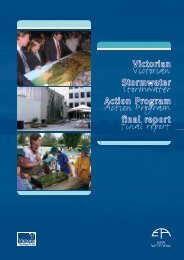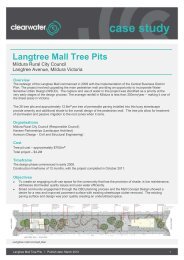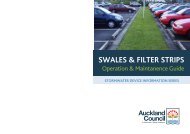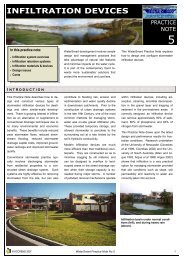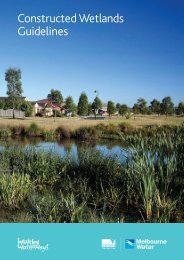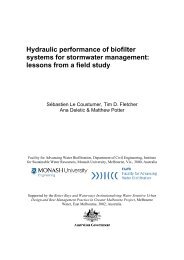CRC Street Sweep Eval 1999.pdf( 489.9 KB ) - Clearwater
CRC Street Sweep Eval 1999.pdf( 489.9 KB ) - Clearwater
CRC Street Sweep Eval 1999.pdf( 489.9 KB ) - Clearwater
You also want an ePaper? Increase the reach of your titles
YUMPU automatically turns print PDFs into web optimized ePapers that Google loves.
COOPERATIVE RESEARCH CENTRE FOR CATCHMENT HYDROLOGY<br />
8 Gross Pollutant Wash-Off<br />
Characteristics<br />
8.1 Gross Pollutant Load Generation<br />
The study by Allison et al. (1998) showed that<br />
stormwater runoff is the principal means by which<br />
gross pollutants are transported to the stormwater<br />
system. Ten storm events (larger than 3 mm of<br />
rainfall) and their transported gross pollutant loads in<br />
the Melbourne suburb of Coburg were monitored<br />
using the CDS unit from May to August 1996<br />
(Allison et al., 1998). Monitoring was carried out in a<br />
50 hectare catchment and the amount of gross<br />
pollutants transported during each of the 10 events<br />
was found to be correlated with the event rainfall<br />
depth as shown in Figure 8.1. A similarly high<br />
correlation between the gross pollutant load retained<br />
in the CDS unit and event runoff was also obtained as<br />
shown in Figure 8.2.<br />
According to the fitted relationship between the wet<br />
gross pollutant load generated and the depth of<br />
rainfall (see Figure 8.1), events of less than 3.7 mm<br />
may be considered to be insufficient for remobilisation<br />
and transport of deposited street surface<br />
loads. The corresponding threshold for runoff (see<br />
Figure 8.2) is 0.70 mm. The fitted relationships<br />
between gross pollutant wet load and event rainfall<br />
depth or runoff show a trend of increasing gross<br />
pollutant load with increasing rainfall or runoff.<br />
Although the curves are monotonically increasing, the<br />
rate of increase in gross pollutant loads decreases<br />
with rainfall and runoff indicating a possible upper<br />
limit of gross pollutant load transported into the<br />
stormwater system during large rainfall or runoff<br />
events. The fitted curves in Figure 8.1 and 8.2 may<br />
be interpreted as indicating that the limiting<br />
mechanism for stormwater gross pollutant transport,<br />
in the majority of cases, is not the supply of gross<br />
pollutants but rather the processes (ie. the stormwater<br />
runoff rates and velocities) influencing the<br />
mobilisation and transport of these pollutants.<br />
If the mobilisation and transportation of gross<br />
pollutants from the street surface depends on a<br />
rainfall depth greater than 3.7 mm, it is likely that the<br />
inter-event dry period for gross pollutant transporting<br />
storm events, in Melbourne will be longer than the<br />
calculated 2.6 days for all recorded storm events.<br />
Analysis of the cumulative frequency distribution of<br />
event rainfall depth for Melbourne over a 105 year<br />
record is presented in Figure 8.3. The analysis shows<br />
that approximately 35% of all recorded rainfall events<br />
are greater than 3.7 mm giving an average inter-event<br />
dry period of 178 hours (7.4 days) for gross pollutant<br />
transporting storm events.<br />
Figure 8.1 Gross Pollutant Wet Loads v’s Rainfall (after Allison et al., 1998)<br />
25




